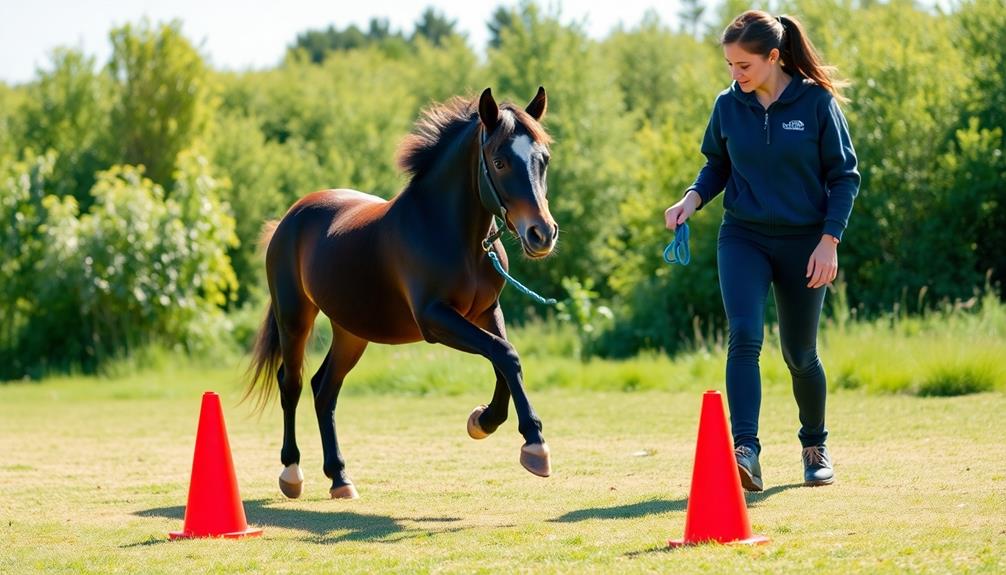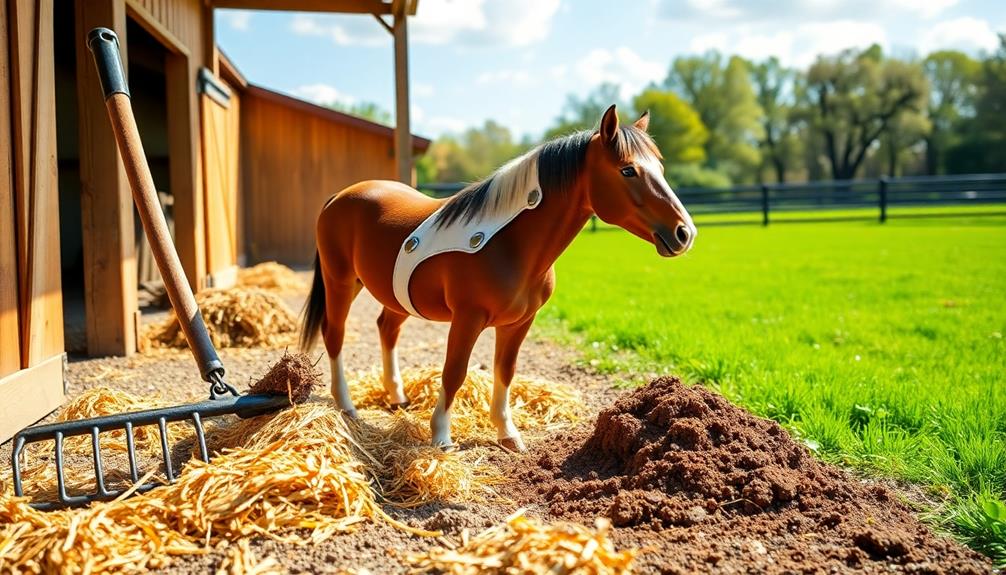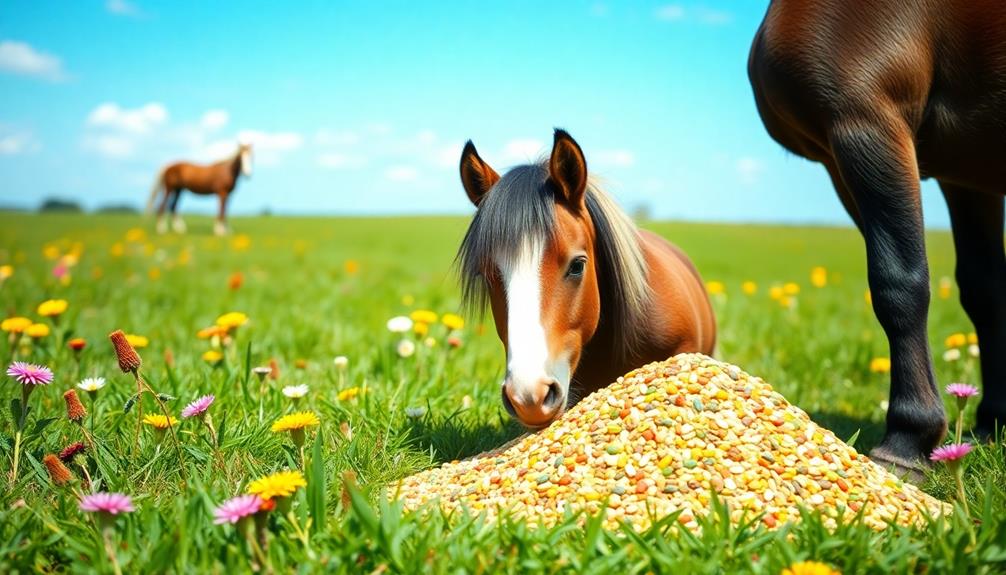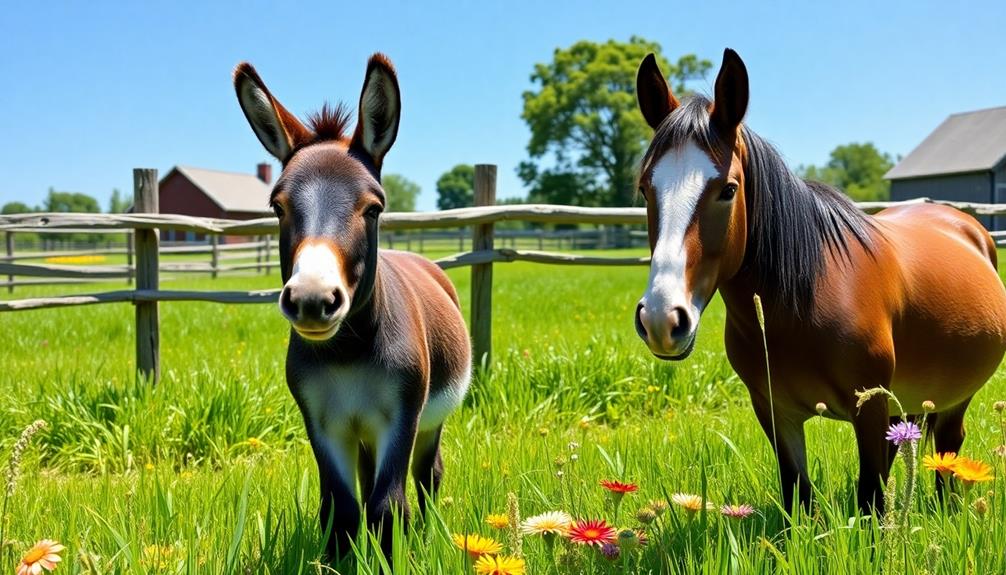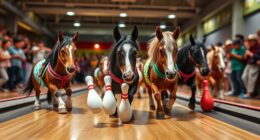Training your miniature horse starts with building trust through gentle handling and consistency. Keep sessions short—15 to 20 minutes—to maintain focus. Use positive reinforcement, like treats and praise, to encourage good behavior. Gradually expose your horse to new stimuli to reduce fear and enhance desensitization. Monitor their emotional state and body language to gauge progress. As they advance, introduce skills like ground driving and obstacle navigation. Recognize signs of relaxation and confidence to adjust your approach. Stay tuned for deeper insights to refine your training methods and reveal their full potential!
Key Takeaways
- Start with desensitization techniques to introduce your miniature horse to various stimuli gradually, building trust and reducing fear.
- Use short training sessions (15-20 minutes) to maintain focus and engagement while teaching basic commands and skills.
- Implement positive reinforcement by offering treats and praise immediately after desired behaviors to enhance learning and motivation.
- Establish respect through consistent handling, eye contact, and body language awareness to foster cooperation during training.
- Advance skills with ground driving and obstacle navigation, using consistent cues to help your horse understand expectations and progress effectively.
Training Techniques Overview
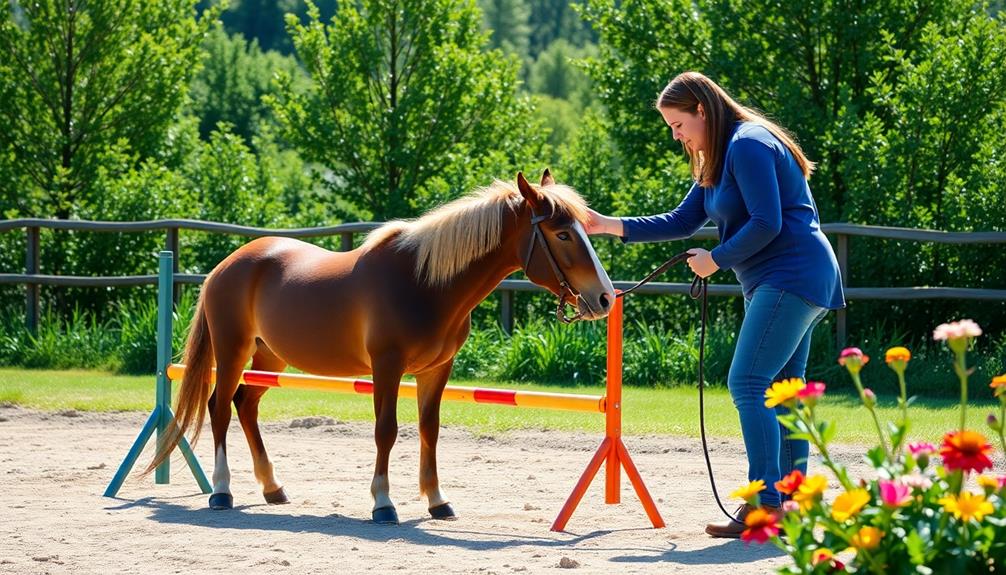
When training a miniature horse, understanding effective techniques is essential for success. One key method is desensitization, which involves exposing your horse to various stimuli, like a crinkly plastic grocery sack. This helps reduce fear responses and makes your horse more comfortable with new experiences.
You'll also want to focus on moving your horse's feet during training. This mimics natural herd dynamics and establishes respect, creating a healthier trainer-horse relationship.
Pay attention to your horse's signs of relaxation, such as blinking and a lowered head. Recognizing these cues allows you to adjust your training techniques to better suit their emotional state.
Keep your training sessions short—around 15-20 minutes—so your miniature horse stays focused and engaged while making noticeable progress.
A balanced approach is important, too. Incorporate rewards, like treats and grooming, alongside gentle discipline. This not only reinforces good behavior but also strengthens the bond between you and your miniature horse.
With patience and consistency, one day you'll see your efforts pay off, leading to a well-trained and happy companion.
Building Respect and Trust
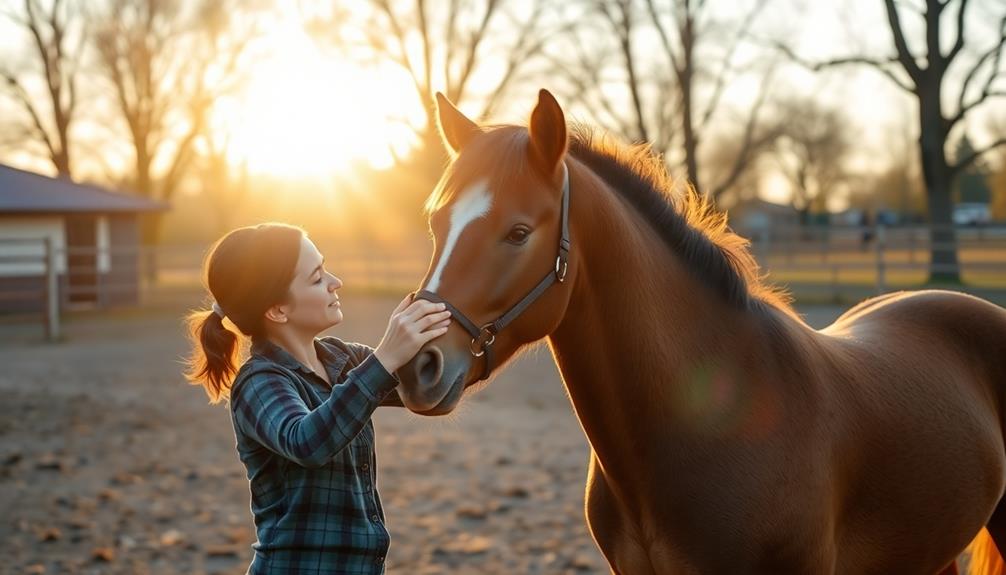
Building respect and trust with your miniature horse is essential for effective training and a strong partnership. Start by moving your horse's feet; this mimics natural herd dynamics and reinforces your authority. When you ask your horse to yield, they're more likely to see you as a leader.
Maintaining eye contact is imperative—if your horse looks away, it may indicate a lack of regard for your leadership.
Use gentle handling techniques, such as soft touches and calm movements, to foster trust. This approach reduces fear and creates a more positive training environment.
Consistency in your training practices is fundamental; it reinforces your position and helps prevent aggressive behaviors during stressful situations.
Pay attention to your horse's body language. Recognizing signs of relaxation, like a cocked leg or a lowered head, can help you gauge their emotional state.
Adjust your interactions accordingly to maintain a respectful bond. By establishing these foundational elements of respect and trust, you pave the way for more advanced training and a deeper connection with your miniature horse.
Recognizing Horse Behavior
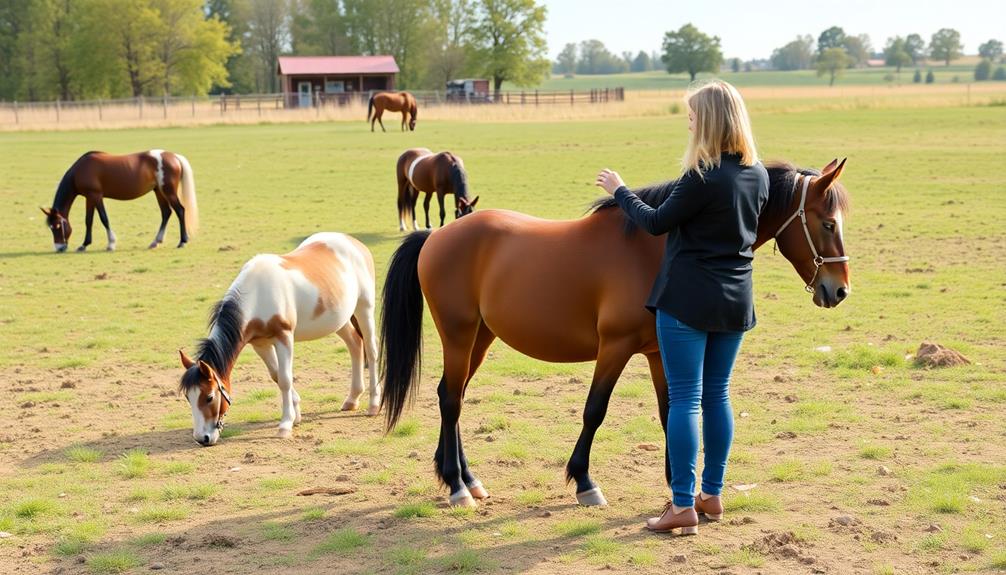
Recognizing horse behavior is key to effective communication and training with your miniature horse. A relaxed miniature horse often shows a cocked leg, signaling comfort in its environment. Look for other signs of relaxation, like blinking, lip licking, and a lowered head. These behaviors indicate that your horse is calm and open to learning.
When introducing new stimuli, it's common for miniature horses to exhibit fear and retreat. With patience, you can help them shift to a more peaceful state. Pay attention to their emotional state, as fluctuations due to environmental factors can affect how responsive they're to training.
It's also essential to recognize disrespectful behaviors. If your miniature horse turns its rear toward you, it's a sign of disrespect that needs addressing. Establishing your authority is critical for a respectful training relationship.
Desensitization Strategies
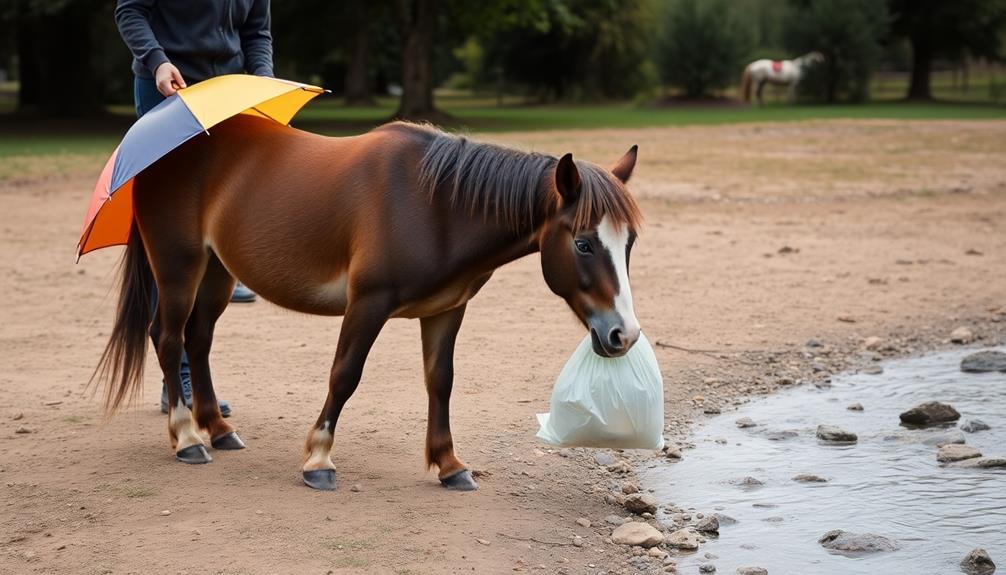
Desensitization is essential for helping your miniature horse adapt to new experiences and reduce fear.
You can use techniques like gradual exposure to different objects, allowing your horse to explore and smell them to build trust.
Consistency and patience during these sessions will lead to a calmer, more confident companion.
Importance of Desensitization
Creating a calm and confident miniature horse is essential for both their safety and your peace of mind. Desensitization plays a vital role in achieving this goal. By reducing fear responses to unfamiliar stimuli, you can prevent dangerous behaviors and foster a more harmonious relationship with your miniature horse.
Using simple techniques, like exposing your horse to a plastic grocery sack to introduce crinkly sounds, can help them become accustomed to new experiences. Allowing your horse to smell the object during this process builds familiarity and trust, making training smoother.
It's important to observe your horse's body language; relaxed postures and signs of calmness indicate that your desensitization efforts are working.
Consistent sessions lasting around 15-20 minutes are key to effective desensitization. Engaging in these brief, focused training periods can lead to significant improvements in your horse's ability to cope with new stimuli.
Ultimately, the importance of desensitization can't be overstated—it promotes a safe environment for both you and your miniature horse, allowing you to enjoy your time together without unnecessary stress.
Techniques for Exposure
Utilizing gradual exposure techniques is essential for effectively desensitizing your miniature horse to new stimuli. Begin by introducing low-stress objects, like crinkly plastic grocery sacks, allowing your horse to investigate them at their own pace. Rubbing the item gently against their body helps build familiarity and comfort, while letting them smell it fosters trust.
Pay close attention to your horse's emotional responses during these sessions. Look for signs of relaxation, such as blinking or lip licking, which indicate they're acclimatizing. Consistency is key; aim for exposure sessions lasting about 15-20 minutes. This routine can lead to significant improvements in your horse's behavior and calmness over time.
After successful exposure, reinforce positive reactions with treats or grooming. This not only solidifies their learning but also encourages a willingness to face new challenges in the future.
Building Trust Gradually
Building trust with your miniature horse is an essential part of the training process, and it starts with gentle, consistent interactions. To effectively desensitize your horse, gradually introduce new stimuli.
Begin with something simple, like a crinkly plastic grocery sack. Allow your horse to sniff the object first, fostering a sense of familiarity. Once your horse seems comfortable, gently rub the object on its body to further reassure it.
As you work through desensitization, pay close attention to your horse's body language. Look for signs of relaxation, such as a cocked leg or lip licking. These cues indicate that your horse is becoming more at ease with the new experience.
Always use consistent, gentle handling during your sessions; this builds trust and respect, making it easier for your horse to accept unfamiliar situations.
Reinforce positive behavior by offering treats and grooming as rewards. Timely rewards enhance learning and encourage continued progress in desensitization.
Indicators of Training Progress
As you train your miniature horse, look for signs of relaxation, like a lowered head or relaxed ears, which indicate comfort in the training environment.
Notice any positive behavioral changes, such as the horse calmly exploring new stimuli or engaging more during sessions.
These indicators show that your efforts are paying off and help you gauge the effectiveness of your training approach.
Signs of Relaxation
Recognizing your miniature horse's signs of relaxation is essential for gauging training progress. One common indicator is a cocked leg, which shows your horse is at ease during training sessions.
Pay attention to other signs, like blinking, lip licking, and a lowered head position. These behaviors suggest your horse is experiencing a calm emotional state, indicating that your training approach is effective.
As you work with your horse, you might notice that initial fearful reactions begin to transform into calmness. This change demonstrates progress in your desensitization and trust-building efforts.
Observing these signs during training helps you assess your horse's emotional state and adjust your methods accordingly. For instance, if your horse shows signs of tension, it may be time to slow down and offer reassurance.
Recognizing and reinforcing these signs of relaxation contributes to fostering a positive training environment. When your horse feels relaxed, it can lead to better overall behavior and cooperation.
Keep an eye out for these indicators; they're valuable tools in your training journey, helping you build a deeper bond with your miniature horse while ensuring both of you enjoy the process.
Positive Behavioral Changes
Positive behavioral changes in your miniature horse are crucial indicators of training progress. When you notice your horse chewing or trying to eat during sessions, it shows they're becoming comfortable with the training process. A major milestone is their ability to remain calm, which not only enhances desensitization but also builds a trusting relationship between you both.
You might see the first signs of improvement within just 15-20 minutes into a training session. This quick adaptability is a positive sign! Look for relaxed postures, like a cocked leg, and behaviors such as blinking or lip licking; these indicate that your horse is becoming more responsive.
To encourage these positive changes, consistent reinforcement is essential. Using treats and grooming as rewards, and ensuring you time them well, can greatly enhance your horse's comfort level and willingness to learn.
Overcoming Training Challenges
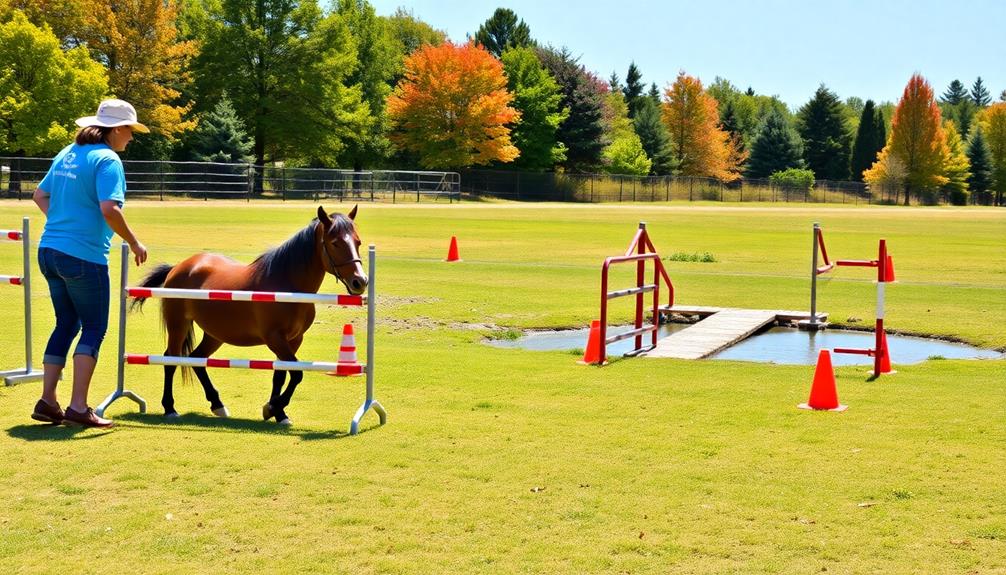
Training a miniature horse can come with its fair share of challenges, especially when fear and anxiety enter the equation. Recognizing signs of fear, like retreating or tense posture, is essential for addressing these challenges effectively.
It's important to create a calm environment where your horse feels safe. Establishing respect is key; use techniques like moving the horse's feet and maintaining eye contact to remedy high-energy behaviors and promote cooperation during training.
Desensitizing your horse to unfamiliar stimuli can also help. Introduce crinkly objects, such as plastic grocery sacks, slowly to reduce anxiety over time. Remember, patience and gentle handling are vital. If you encounter frustration, take a step back.
Short training sessions of 15-20 minutes are ideal for observing progress and making necessary adjustments.
Keep in mind that rewarding good behavior promptly can reinforce positive actions and encourage continued effort. By focusing on these strategies, you'll create a more positive training experience for both you and your miniature horse.
With dedication and understanding, you can overcome these challenges and build a strong bond with your equine companion.
Rewarding Positive Behavior

Encouraging good behavior in your miniature horse is essential for effective training. Rewarding positive actions not only reinforces those behaviors but also creates a strong bond between you and your horse.
Here are three effective ways to reward your miniature horse:
- Treats: Offering small, healthy treats immediately after your horse performs the desired behavior helps them associate the action with a positive outcome.
- Grooming and Brushing: Incorporate grooming as a reward. The soothing touch of a brush not only reinforces good behavior but also deepens your relationship, fostering trust.
- Praise and Affection: Never underestimate the power of your voice and touch. A kind word or gentle pat can be just as motivating as treats, boosting your horse's confidence.
Timing is critical when providing these rewards. Be sure to give them right after the desired behavior to enhance learning and retention.
Keep a close eye on your horse's reactions to adjust rewards based on their preferences. Balancing discipline with these rewards will create a positive training environment, making your miniature horse more willing to learn and engage.
Communication and Bonding
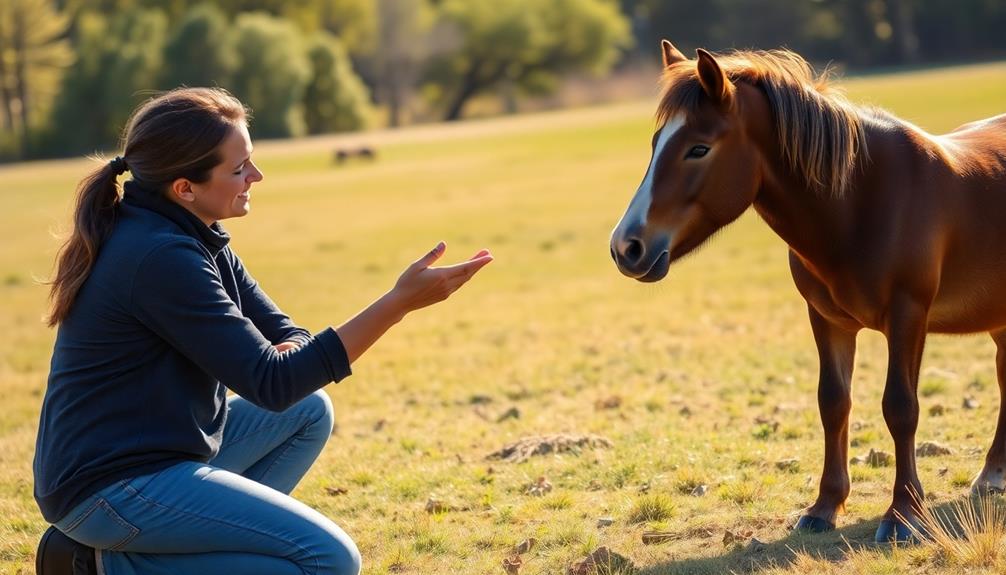
Effective communication with your miniature horse is key to building a strong bond and fostering trust. To establish this connection, start by understanding Smokey's body language. Pay attention to his relaxed postures and maintain eye contact; these signals indicate his comfort and respect for you.
Use gentle handling techniques, consistent guidance, and positive reinforcement to promote a close relationship. Recognizing Smokey's emotional state is vital, too. If he shows signs of fear or anxiety, adjust your approach to enhance his comfort and willingness to engage.
This responsiveness not only eases his stress but also strengthens your bond. Incorporate desensitization techniques, like exposing him to a plastic grocery sack, to create positive experiences and reduce his fears.
Regularly observe and reflect on your interactions during training sessions. This continuous evaluation allows you to adjust your communication strategies, fostering a more profound relationship with Smokey.
Advancing Skills and Techniques
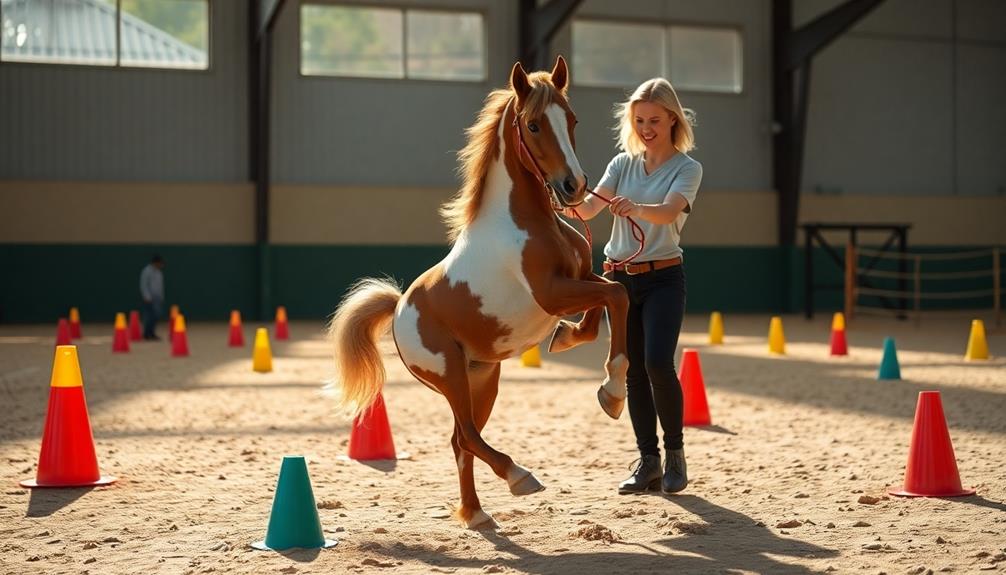
Once you've established a solid foundation of trust and communication with your miniature horse, you can start introducing more advanced skills like ground driving and obstacle navigation.
To enhance your training sessions, focus on these key techniques:
- Ground Driving: Use long lines to guide your horse while you walk behind. This helps them learn to respond to cues even when you're not beside them.
- Obstacle Navigation: Set up a small course with cones, poles, and other items. Encourage your horse to navigate through these obstacles, rewarding them for successful attempts.
- Consistent Cues: Utilize clear signals for commands. This consistency helps your horse understand what you expect as they progress to more complex tasks.
Always remember to incorporate positive reinforcement, like treats or grooming, to keep your miniature horse motivated.
Monitor their emotional responses; a calm demeanor from you is essential for their confidence.
Regularly assess their progress and make adjustments to your training as needed.
Frequently Asked Questions
Are Mini Horses Hard to Train?
Mini horses can be challenging to train due to their energy and initial behavior. However, with patience, consistency, and effective techniques like desensitization, you'll see improvements quickly, making the process rewarding and enjoyable.
What Are the Disadvantages of Miniature Horses?
While miniature horses can be adorable, they come with disadvantages. You'll face health concerns, limited utility for riding, higher care costs, and potential behavioral issues, which might challenge your expectations of owning one.
At What Age Is a Miniature Horse Full Grown?
A miniature horse typically reaches full growth between 3 and 5 years old, averaging around 34 inches tall. However, they can continue to develop muscle and fill out until around 7 years of age.
How Do You Keep a Mini Horse From Foundering?
To keep your mini horse from foundering, focus on balanced nutrition, maintain regular hoof care, encourage consistent exercise, monitor body condition, and schedule vet check-ups. Prevention's key, so stay proactive in their care!
Conclusion
Training your miniature horse is like nurturing a delicate flower; with patience and care, it'll blossom into a confident companion. By fostering respect, understanding behavior, and using positive reinforcement, you're laying the groundwork for a strong bond. As you advance skills and overcome challenges, remember that each small success is a step toward a beautiful partnership. So, keep nurturing that connection, and watch as your miniature horse flourishes in ways you never imagined!
